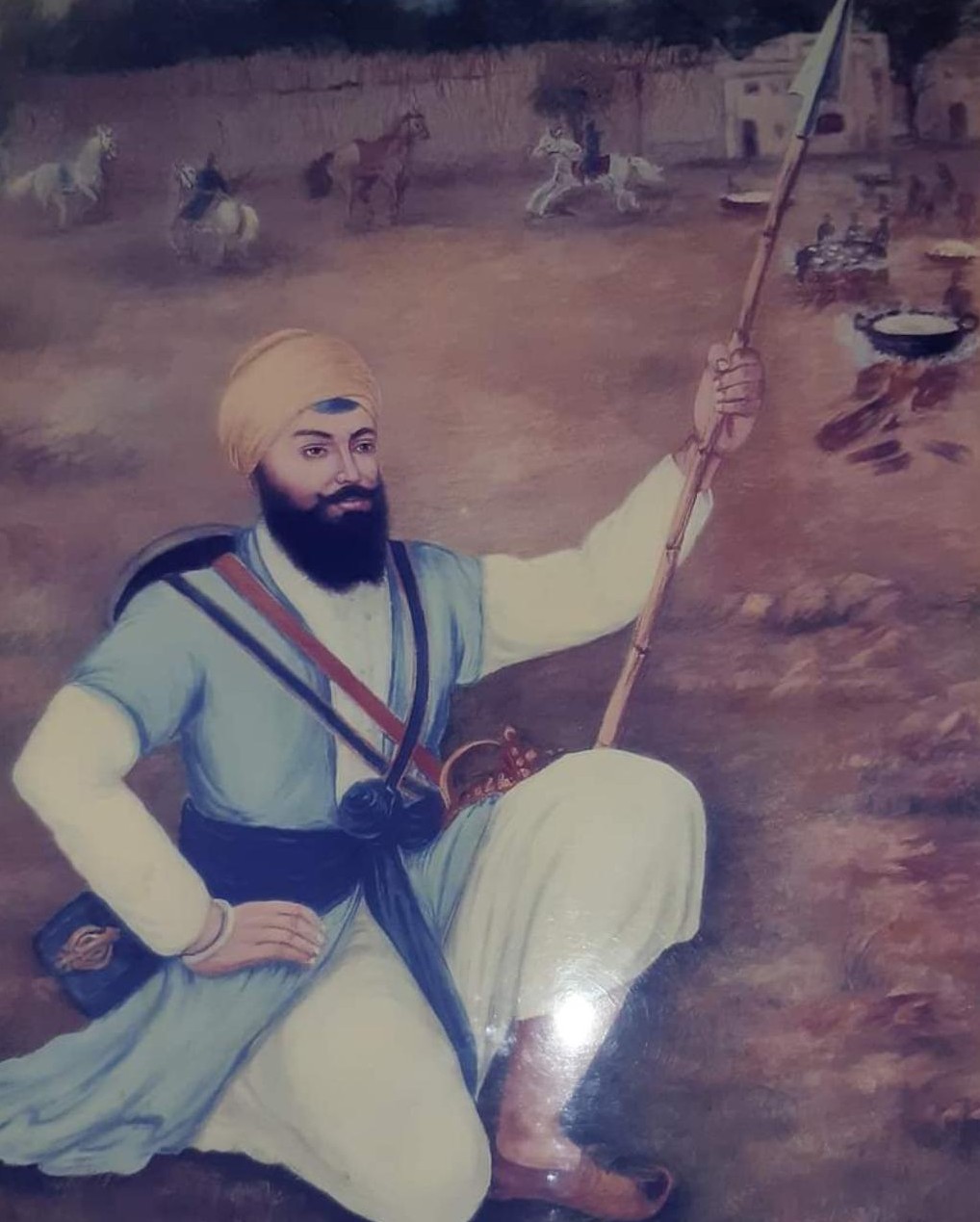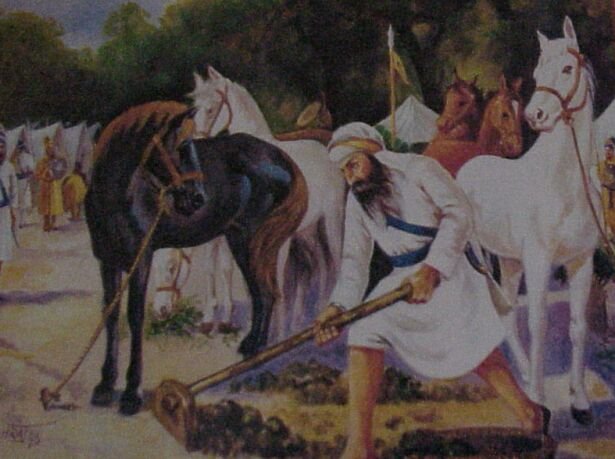Bhai Tara Singh Wan was an 18th-century Sikh martyr known for his faith and bravery . Born in 1687 in the village of Wan, now in Tarn Taran district, Punjab, he played a significant role in defending Sikh principles during a time of persecution.

Early Life and Background
Bhai Tara Singh was born into a family deeply rooted in Sikh faith and bravery. His father, Sardar Gurdas Singh, was a dedicated Sikh who had received Amrit from Guru Gobind Singh Ji and had participated in the Battle of Amritsar in 1709.
The battle saw Sikh forces, led by Bhai Mani Singh, fighting against the Mughal Empire’s forces. This historical battle, where his father played a pivotal role, had a profound impact on Tara Singh’s upbringing. Growing up in an environment that combined spirituality and a strong sense of duty, Tara Singh developed both a strong commitment to Sikh values and a sense of courage from an early age. The dedication of his family to Sikh ideals greatly shaped his own aspirations and set the foundation for his later achievements.
Initiation into the Khalsa
Following the path of his father, Bhai Tara Singh was initiated into the Khalsa by Bhai Mani Singh, a revered Sikh leader and martyr. The ceremony of receiving Amrit (Sikh initiation) marked his formal entry into the Khalsa, which embodied the core principles of Sikhism, including devotion to God, service to humanity, and the defense of the weak. Bhai Tara Singh’s initiation further solidified his role in the Sikh community.
Known for his deep devotion to the Sikh faith, he also trained in martial arts, which was a crucial aspect of the Khalsa tradition. His expertise in martial skills, combined with his strong spiritual foundation, made him a prominent figure in the Sikh community, embodying the warrior spirit of Sikhism. Bhai Tara Singh’s life as a Khalsa soldier was dedicated to both upholding the Sikh faith and defending his community against external threats.
Establishment of a Sanctuary
During a time when Sikhs faced severe persecution under Mughal rule, Bhai Tara Singh recognized the need to protect his fellow Sikhs. In response to the oppression, he took decisive action and built a fortified dwelling in his village, known as a ‘vaar.’ This sanctuary, constructed with thick piles of thorny branches, provided a secure refuge for Sikhs who were fleeing from the ongoing violence and persecution.
The ‘vaar’ not only served as a physical shelter but also as a symbol of resilience, as it became a safe space for Sikhs to regroup, find protection, and continue their spiritual practices amidst adversity. Bhai Tara Singh’s sanctuary was a symbol of his leadership, bravery, and his commitment to ensuring the safety of the Sikh community during one of the most difficult periods in their history. His actions reflected the spirit of selflessness and the importance of safeguarding the values of faith and community.
Conflict with Sahib Rai
The conflict between Bhai Tara Singh and Sahib Rai, the local head of Naushahra, stemmed from a series of injustices perpetrated by Sahib Rai toward the Sikh farmers in the area.
Sahib Rai was a cruel and arrogant leader who showed little regard for the welfare of the local Sikh community. One of his most offensive actions was allowing his horses to roam freely and graze on the fields of Sikh farmers. This caused significant damage to the crops, which were essential for the farmers' livelihoods. Despite repeated pleas from the farmers to keep his horses in check, Sahib Rai not only ignored their requests but also insulted them. He even threatened to tie his horses with ropes made from the hair of the farmers, further humiliating them. This blatant disregard for the well-being of the Sikh farmers sparked outrage and left the farmers feeling helpless and vulnerable in the face of such an oppressive figure.
In their desperation, the farmers turned to Bhai Tara Singh for help. Tara Singh, a figure known for his dedication to justice and the defense of Sikh principles, was deeply moved by the injustice faced by the farmers. As a defender of the community, he knew that action was necessary to teach Sahib Rai a lesson and protect the rights of his fellow Sikhs.
Retaliation and Escalation
In response to Sahib Rai's oppression, Bhai Tara Singh and his companions took decisive action. Determined to retaliate against Sahib Rai’s tyranny, they captured the horses belonging to Sahib Rai and sold them. The money earned from this sale was then used to provide for the Sikh community and to support the livelihoods of those who had been affected by the cruel treatment of Sahib Rai. This act of retaliation was not only a way of punishing Sahib Rai for his mistreatment of the Sikh farmers but also a message to the broader community that the Sikhs would not tolerate injustice or oppression.

Enraged by the loss of his horses and the defiance of Bhai Tara Singh, Sahib Rai sought retribution by appealing to Jafar Beg, the faujdar (military commander) of Patti. Sahib Rai accused Bhai Tara Singh of harboring criminals and causing unrest in the region. This complaint was taken seriously by Jafar Beg, who ordered a military response. A contingent of 25 horsemen and 80 foot soldiers was dispatched to apprehend Bhai Tara Singh and restore order, demonstrating the lengths to which the Mughal authorities were willing to go in order to suppress the growing defiance of the Sikh community.
First Battle and Victory
Despite being vastly outnumbered, Bhai Tara Singh and his band of 22 loyal men refused to back down. They stood firm, prepared to defend their actions and protect their community from the Mughal forces. The battle that ensued was a fierce one, with Bhai Tara Singh’s small group of warriors fighting valiantly against the much larger Mughal force. The Sikh fighters, though outnumbered, showed exceptional courage, strategy, and resilience. Their swift and coordinated efforts led to the death of several Mughal soldiers, including the nephew of Jafar Beg, who was a key figure in the Mughal contingent.
The victory of Bhai Tara Singh and his men in this battle was a remarkable achievement, given the difference in numbers and resources. The Sikhs' resilience in the face of overwhelming odds was a reflection of their courage and dedication to their principles. This victory not only boosted the morale of Bhai Tara Singh’s band but also sent a strong message to the Mughal forces and the local community that the Sikhs would not be easily subdued. The victory was a source of pride for the Sikh community and became an emblem of their strength and determination to defend their rights, their land, and their faith. It also reinforced Bhai Tara Singh's reputation as a courageous leader who would go to great lengths to protect his community from injustice.
Martyrdom
After Bhai Tara Singh’s decisive victory against the Mughal forces, the local Mughal authorities, led by Jafar Beg, reported the incident to the Governor of Lahore, Zakariya Khan. Furious at the defeat and the growing resistance from the Sikhs, Zakariya Khan ordered a much larger punitive expedition to subdue Bhai Tara Singh and his followers. To ensure the elimination of the Sikh threat, Zakariya Khan dispatched a massive force of 2,000 horsemen, five elephants, 40 light camel guns, and four cannons. This formidable army was led by Deputy Momin Khan, who was tasked with crushing Bhai Tara Singh's resistance and restoring Mughal control over the region.
Despite being heavily outnumbered and facing an overwhelming military force, Bhai Tara Singh and his small band of warriors refused to surrender. With remarkable bravery and determination, they held off the Mughal forces for an entire night, using strategic positions and their knowledge of the terrain to their advantage. The Sikhs fought bravely, demonstrating their commitment to the defense of their faith and community. The following day, the battle intensified into fierce hand-to-hand combat.
However, despite their courage and resilience, Bhai Tara Singh and his men were ultimately martyred on March 30, 1726. Their sacrifice marked a significant moment in Sikh history, as they became symbols of selfless devotion to the cause of Sikhism and the protection of their community.
Bhai Tara Singh’s martyrdom highlighted the lengths to which Sikhs were willing to go in the face of tyranny and persecution. His legacy as a martyr continues to inspire Sikhs worldwide, reminding them of the importance of standing firm in their beliefs, even at the cost of their lives.
Final Sacrifice & Memorials
Following the intense battle, Bhai Tara Singh Wan and his 22 companions were martyred on 30 March 1726 while fighting against the Mughal forces. Their sacrifices became a symbol of Sikh resistance against oppression.
After their execution, their severed heads were taken back to Lahore and thrown into a blind well at Landa Bazar, where Gurdwara Shaheed Singhania now stands. This site commemorates their sacrifice and reminds visitors of the brutality Sikhs faced under Mughal rule.
A Gurdwara Sahib was also built at the location where Bhai Tara Singh and his 22 companions were cremated. This shrine continues to be a place of remembrance and reverence, honoring the martyrs who gave their lives for their faith.
Conclusion
Bhai Tara Singh’s life and martyrdom showcase the dedication and resilience of the Sikh community during a time of immense hardship and persecution. From his early commitment to Sikh principles to his courageous leadership in the face of great challenges, Bhai Tara Singh played a crucial role in defending his people and their values.
His sacrifice on the battlefield in 1726 remains a powerful symbol of selflessness and devotion to faith, and his legacy continues to inspire Sikhs around the world. His story serves as a reminder of the importance of standing up for justice, protecting one's community, and remaining firm in the face of oppression.
Note- We have made every effort to ensure the accuracy and reliability of the information provided. However, this content is intended for informational purposes only and reflects historical and cultural perspectives. DVN does not assume responsibility for any disputes or actions that may arise from the use of this content. If you believe any information is incorrect or misleading, please contact us.